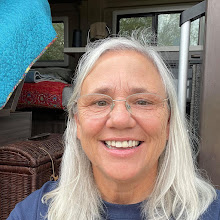On our way into Nauvoo (a little river town) the beauty of the river was enhanced by the water lilies that cover the shorelines and they are in bloom. When we first entered Nauvoo I was amazed at the Mormon temple. It is beyond my compression how they built such a building in those days. There are some of the original buildings carefully restored and others they built using similar floor plans.
Our plan after we get settled in is to explore Nauvoo.
I am interested in Nauvoo not only for its rich history but my family was a part of the Mormon history. They were there in Missouri, Illinois, and were a part of the mass exodus to Utah. I have nothing but admiration for the them because of the hardships they endured for religious freedom.
The history of Nauvoo is interesting yet bittersweet. "In Daviess County non-Mormon settlers grew concerned that the Mormons would seize political control of Daviess County. On August 6, 1838, a group of non-Mormons tried to prevent Mormon settlers from voting in the local elections at Gallatin. The Mormons fought back and defeated the mob. This was the first in a series of conflicts in 1838 that are sometimes called the Mormon War.
In the course of the conflict, non-Mormon vigilantes from neighboring counties came to Daviess and burned Mormon homes. Mormons responded to these attacks by leading their own forces up from Caldwell County. The Mormon militia and Danite groups marched to the non-Mormon settlements of Gallatin, Millport, and Grindstone Forks. They seized the property found in homes and stores and then burned the settlements to the ground. As a result most non-Mormon residents fled the county and their stories increased anti-Mormon sentiment throughout northwestern Missouri.
Missouri's governor, Lilburn Boggs, responded to the crisis with his famous Extermination Order, in which he called out 2,500 militiamen and threatened to drive the Mormons from the state or "exterminate them". The militia caused the Mormons to surrender. Most of the Mormons had left the state by early 1839, the refugees gathered in Illinois
Joseph Smith purchased land on the banks of the Mississippi. They drained the land and began building the city they called Nauvoo, "beautiful place."
The persecutions of the past were not forgotten in Nauvoo. In response to what they saw as the failure of the judicial and political systems to protect them, church leaders negotiated a unique city charter, allowing the city to become almost independent. Joseph Smith headed the municipal system, having the power to issue writs of habeas corpus which were often used to protect Nauvoo's leading citizens (and church members) from harassment by law enforcement agents of other states. The city government was a mayor-council form, and most of the leaders were members of the church. Nauvoo, like other communities, had a community militia. But where other community militias were part of the state militia, Nauvoo's was separate and mostly independent.
This army was chartered by the state of Illinois shortly after Nauvoo was established. The Legion, which had ceremonial duties within the church, soon evolved into an army whose main job was to protect the leadership of the church. The non-Mormons of the area saw this army as a threat to them.
As time went on relations between Mormons and non-Mormons in Illinois quickly deteriorated. A group of three hundred non-Mormons began to attack and burn Mormon homes in rural areas around Nauvoo. The Mormons formed a posse and retaliated. This violence was the beginning of the end for the Mormons in Illinois.
Joseph and Hyrum Smith, along with other church leaders, were imprisoned in Carthage, Illinois, to wait a hearing on charges growing out of the destruction. Although they had been promised protection by the Illinois governor, a mob was able to break through into the jail. On June 27, 1844, the Smith brothers were murdered.
In 1844 the Illinois General Assembly asked the Mormons to leave the state and withdrew the charter for the city of Nauvoo. From there, the Mormons left in 1845 to resettle in Salt Lake City, Utah."
23 hours ago






0 comments:
Post a Comment